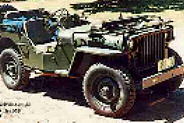 1941-1945:
Willys 2.2L 4cyl side-valve engine.
1941-1945:
Willys 2.2L 4cyl side-valve engine. Pictured is a 1942 Jeep MB.
Only three companies of those 135 complied. These companies were Ford Motor Company, Willys-Overland and American Bantam Car Company. Within five days, Bantam had blueprints in Washington for approval. Willy's prints were turned in later and their vehicle would cost more. Since the government's main concern seems to be money, they set up a contract with Bantam for 70 vehicles. Their model, though, was a pitiful failure under testing by the army quartermaster.
World War II had already broken out in Europe, and so more prototypes were accepted from the other two companies. Willys' model was the best followed by Ford, and then Bantam. Problem arose though, because Willys quarter ton truck carried too much weight according to army specifications. The engineers at Willys stripped their car. Bolts were cut, sheet metal thinned and ten pounds of paint was taken off. When weighed, they had seven ounces to spare. In July of 1941, the army was ready for a large number of these four by fours, and for $738.74 a car, Willys won the contract. Ford agreed to build Willys' blueprint while Bantam built jeep trailers.
The name Jeep comes from the Ford name for it's general purpose vehicle, GP for short. Slurring the letters 'G' and 'P' together sounds like "jeep." Even before the vehicle came into existence the word jeep was common in the military. It had many meanings, from a lazy soldier to a useless piece of machinery. The jeep was also called a puddle jumper, Bantam Bug, Midget, Quad, and the peep. Willys made the word `Jeep' its trademark after World War II.
The Willys Military model MB, or as the army called it, "Truck, quarter ton, four by four, and command reconnaissance," was a mechanically simple machine. In had a four cylinder F-head style engine (where the pistons go sideways instead of up and down), which could operate at 4000 revolutions per minute for 100 hours straight. The air cleaner was improved from earlier models, and the oil filter was placed high up for easy accessibility. It also had a fold up cloth roof, which was easily set up. The six volt battery powered the headlamps, which were mounted on winging levers in order for them to be pointed toward the engine for nighttime repairs. The engine also powered radar, radio, welding, and landing craft equipment. Special care was taken to prevent engine noise from interfering with army radios. It had a three speed manual transmission and four wheel drive transfer case with high and low gears. Over 350,000 MB's were made to fight in World War II.
The first jeeps were used in the United Kingdom before the United States entered in World War II. They were issued to infantry personnel to help fight the Nazi attack on England. They weren't shipped to the Pacific theater until 1943 when the Army used it for more civil purposes. The jeep helped build bridges and roads behind the fighting lines by hauling materials and carrying personnel. But its first real test of durability was demonstrated when a fleet of jeeps headed for China were stranded in Burma. The Army turned the jeeps over to the British Army to be driven north in order to get them to their destination. The jeeps pulled other vehicles out of the mud, dodge snipers, carried ammunition and trudged through rice paddies.
Its performance in World War II was superb. The jeep could operate without strain from three to 60 miles per hour. It could handle a forty degree slope, turn in a thirty foot circle, and tilt left or right on a fifty degree angle without tipping over. It would "go places where tankers quit and birds would go back exhausted." The jeep went up rocky mountains in Switzerland and moved snow off roads in Belgium. Although the tank had an influence on the war too, it could not go as many places as the jeep.
 1941-1945:
Willys 2.2L 4cyl side-valve engine.
1941-1945:
Willys 2.2L 4cyl side-valve engine.
Pictured is a 1942 Jeep MB.
 CJ2A: 1945-1949, first civilian Jeep.
CJ2A: 1945-1949, first civilian Jeep.
 CJ-3B: 1953-1964,
one piece wind-screen, low wipers.
CJ-3B: 1953-1964,
one piece wind-screen, low wipers.
Note the high hood to clear the taller F-head (ioev) motor.
 CJ-5: 1955-1969 one piece windscreen, high wipers.
CJ-5: 1955-1969 one piece windscreen, high wipers.
 CJ-6: 1955-1969 one piece windscreen, high wipers, 101" wheelbase.
CJ-6: 1955-1969 one piece windscreen, high wipers, 101" wheelbase.
Many people believe that 100" is the ideal wheel base, 90" being a bit short, restricting load capacity and giving a choppy ride on-road, 110" restricting manoeuvrability off-road. Despite that, the CJ-6 was one of the less popular Jeeps.
 CJ-7: 1976-? soft-top or removable plastic hard-top.
CJ-7: 1976-? soft-top or removable plastic hard-top.
 **Here's My Favorite, I'm a little partial since I own one!**
**Here's My Favorite, I'm a little partial since I own one!**
CJ-8:
Thanks owed to Softcom and Michael VanderPloeg